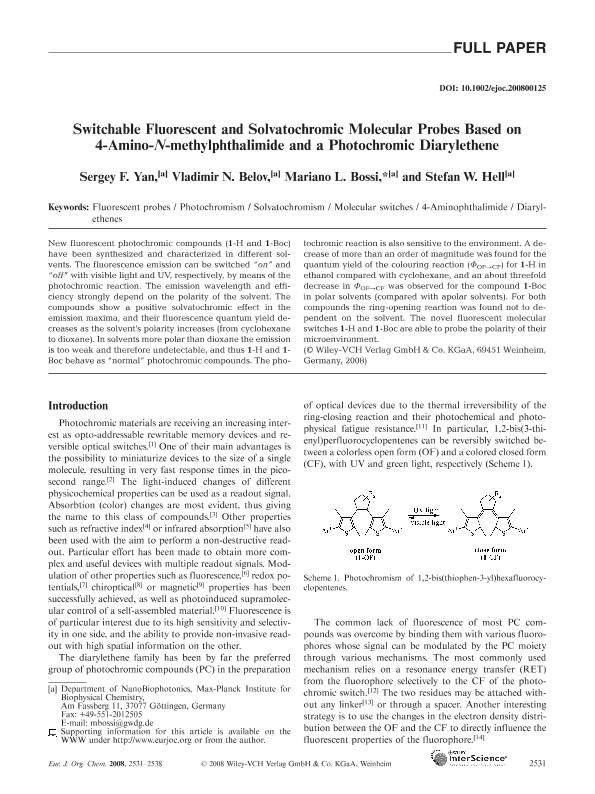Mostrar el registro sencillo del ítem
dc.contributor.author
Yan, Sergey F.
dc.contributor.author
Belov, Vladimir N.
dc.contributor.author
Bossi, Mariano Luis

dc.contributor.author
Hell, Stefan W.
dc.date.available
2020-04-20T15:25:45Z
dc.date.issued
2008-05
dc.identifier.citation
Yan, Sergey F.; Belov, Vladimir N.; Bossi, Mariano Luis; Hell, Stefan W.; Switchable Fluorescent and Solvatochromic Molecular Probes Based on 4-Amino-N-methylphthalimide and a Photochromic Diarylethene; Wiley VCH Verlag; European Journal of Organic Chemistry; 2008; 15; 5-2008; 2531-2538
dc.identifier.issn
1434-193X
dc.identifier.uri
http://hdl.handle.net/11336/103010
dc.description.abstract
New fluorescent photochromic compounds (1-H and 1-Boc)have been synthesized and characterized in different solvents.The fluorescence emission can be switched “on” and“off” with visible light and UV, respectively, by means of thephotochromic reaction. The emission wavelength and efficiencystrongly depend on the polarity of the solvent. Thecompounds show a positive solvatochromic effect in theemission maxima, and their fluorescence quantum yield decreasesas the solvent’s polarity increases (from cyclohexaneto dioxane). In solvents more polar than dioxane the emissionis too weak and therefore undetectable, and thus 1-H and 1-Boc behave as “normal” photochromic compounds. The photochromic reaction is also sensitive to the environment. A decreaseof more than an order of magnitude was found for thequantum yield of the colouring reaction (ΦOFCF) for 1-H inethanol compared with cyclohexane, and an about threefolddecrease in ΦOFCF was observed for the compound 1-Bocin polar solvents (compared with apolar solvents). For bothcompounds the ring-opening reaction was found not to dependenton the solvent. The novel fluorescent molecularswitches 1-H and 1-Boc are able to probe the polarity of theirmicroenvironment.
dc.format
application/pdf
dc.language.iso
eng
dc.publisher
Wiley VCH Verlag

dc.rights
info:eu-repo/semantics/openAccess
dc.rights.uri
https://creativecommons.org/licenses/by-nc-sa/2.5/ar/
dc.subject
Fluorescent probes
dc.subject
photochromism
dc.subject
Solvatochromism
dc.subject
Molecular switches
dc.subject
4-Aminophthalimide
dc.subject.classification
Físico-Química, Ciencia de los Polímeros, Electroquímica

dc.subject.classification
Ciencias Químicas

dc.subject.classification
CIENCIAS NATURALES Y EXACTAS

dc.title
Switchable Fluorescent and Solvatochromic Molecular Probes Based on 4-Amino-N-methylphthalimide and a Photochromic Diarylethene
dc.type
info:eu-repo/semantics/article
dc.type
info:ar-repo/semantics/artículo
dc.type
info:eu-repo/semantics/publishedVersion
dc.date.updated
2020-04-17T14:42:01Z
dc.journal.volume
2008
dc.journal.number
15
dc.journal.pagination
2531-2538
dc.journal.pais
Alemania

dc.journal.ciudad
Weinheim
dc.description.fil
Fil: Yan, Sergey F.. Max Planck Institute for Biophysical Chemistry; Alemania
dc.description.fil
Fil: Belov, Vladimir N.. Max Planck Institute for Biophysical Chemistry; Alemania
dc.description.fil
Fil: Bossi, Mariano Luis. Max Planck Institute for Biophysical Chemistry; Alemania. Consejo Nacional de Investigaciones Científicas y Técnicas. Oficina de Coordinación Administrativa Ciudad Universitaria. Instituto de Química, Física de los Materiales, Medioambiente y Energía. Universidad de Buenos Aires. Facultad de Ciencias Exactas y Naturales. Instituto de Química, Física de los Materiales, Medioambiente y Energía; Argentina
dc.description.fil
Fil: Hell, Stefan W.. Max Planck Institute for Biophysical Chemistry; Alemania
dc.journal.title
European Journal of Organic Chemistry

dc.relation.alternativeid
info:eu-repo/semantics/altIdentifier/url/https://chemistry-europe.onlinelibrary.wiley.com/doi/abs/10.1002/ejoc.200800125
dc.relation.alternativeid
info:eu-repo/semantics/altIdentifier/doi/http://dx.doi.org/10.1002/ejoc.200800125
Archivos asociados
